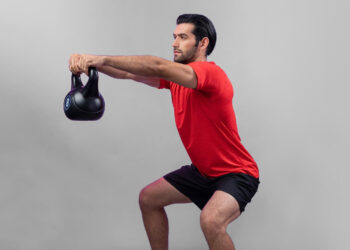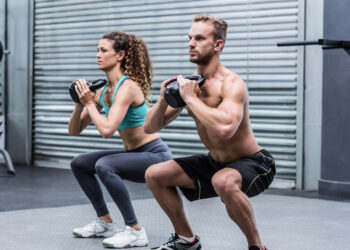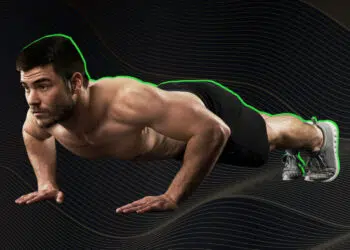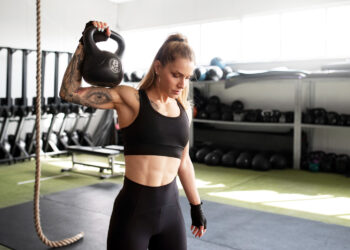At some point, almost every exerciser wants to get six-pack abs. A six-pack involves getting your body fat low enough that the outline of your abs shows through your skin. Because of this, getting a six-pack usually means eating less and lowering your body fat.
That said, there are exercises you can do that will strengthen and thicken your abdominal muscles to make them visible sooner. So, while it’s true that six-pack abs are made in the kitchen, what you do in the gym matters, too. If you are serious about getting a six-pack, it’s time to get serious about your abs training!
In this article, we look at why and how to do the Spiderman plank, a straightforward yet challenging exercise that will take your plank workout to a whole new level!
Spiderman Planks – Muscles Worked
The Spiderman plank works your core, which is the collective name for the muscles of your midsection. The core encircles your waist like a corset or weightlifting belt and controls the movements of your spine.
In addition, when all the muscles of the core contract together, they create inward pressure, stabilizing your spine and preventing unwanted movement. This is called bracing, which is their main function during Spiderman planks.
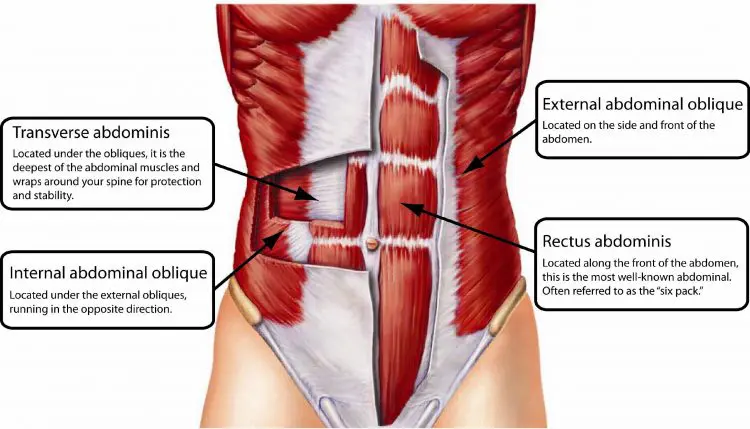
The primary muscles that make up the core are:
Level Up Your Fitness: Join our 💪 strong community in Fitness Volt Newsletter. Get daily inspiration, expert-backed workouts, nutrition tips, the latest in strength sports, and the support you need to reach your goals. Subscribe for free!
Rectus abdominis
Located on the front of your abdomen, the rectus abdominis is usually called the abs for short. This long flat muscle runs from your lower ribs down to your pelvis and is divided into sections by lines of ligamentous tissue. It’s these lines that give your abs their six-pack appearance – providing you are lean enough to see them, that is!
The functions of the rectus abdominis are flexion and lateral flexion of the spine and compression of the abdominal contents.
Obliques
The obliques are located on either side of your abdomen and are positioned diagonally. There are two sets of oblique muscles – the internal and external obliques. The obliques are essentially your waist muscles. Developing your obliques will provide a good-looking “frame” for your abs.
The functions of the obliques are rotation and lateral flexion of the spine. During Spiderman planks, the obliques work to stabilize your spine and stop your hips from twisting.
Transverse abdominis
Known as the TVA for short, this muscle is located beneath your rectus abdominis and obliques. While it IS out of sight, it’s still an important muscle.
The TVA encircles your abdominal contents and squeezes inward to create intra-abdominal pressure, stabilizing your spine and preventing unwanted movement during Spiderman planks.
A strong TVA can help prevent back pain and improve your posture.
Hip flexors and quadriceps
While your core is the most active muscle group during Spiderman planks, the hip flexors and quadriceps are also engaged. These muscles keep your knees and hips extended so that your core is loaded appropriately. However, the tension on the hip flexors and quads is relatively low, so don’t worry if you can’t really feel them working.
Chest, shoulders, and triceps
Spiderman planks are performed in a push-up position or resting on your elbows and forearms. Regardless of which option you choose, your upper body will be working to hold your body in the correct posture. As such, Spiderman push-ups provide your main upper body muscles with a small but worthwhile workout.
How to Do Spiderman Planks
Get more from Spiderman planks while keeping your risk of injury to a minimum by following these guidelines:
- Lie on your front on the floor with your legs straight. Use an exercise mat for comfort. Pull your toes up so the balls of your feet are pressed into the floor.
- Place your forearms flat on the floor with your hands about shoulder-width apart and parallel. Your elbows should be directly under your shoulders.
- Brace your abs, engage your arms, shoulders, and chest, and lift your hips off the floor, so your body is straight. This is your starting position.
- Bend one leg and pull your knee out and up to the outside of your elbow. Turn your hip out to keep your knee clear of the floor.
- Slowly extend your leg, swap sides, and repeat.
- Alternate legs for the duration of your set.
Tips:
- Take care not to hold your breath during Spiderman planks, as doing so could increase your blood pressure or make you feel faint.
- Place your arms on a raised platform, e.g., a bench, to make it easier.
- Rest your arms on an unstable surface, e.g., a BOSU ball, to make it harder.
- Do Spiderman planks for reps or time as preferred.
- You can also do Spiderman planks with straight arms, i.e., in the push-up position, like this:
Spiderman Plank Benefits and Drawbacks
Benefits
Not sure if Spiderman planks deserve a place in your core workouts? Consider these benefits and then decide!
1. Anywhere, anytime
You don’t need any equipment to do Spiderman planks, so they’re an excellent exercise for home workouts or gyms with limited training equipment. You can also do them outdoors, in a hotel room, or pretty much anywhere you want. Do the push-up version if you don’t want to lie on the floor.
2. An upgrade to regular planks
Regular planks are a useful exercise, but if you do them often enough, they’ll eventually become boring and may not provide your abs with much of a challenge. Spiderman planks are a little more demanding, making them an ideal progression if you have mastered the standard variation.
3. Quick set-up
It takes no more than a few seconds to get into position to do Spiderman planks. As such, it’s a good exercise for fast-paced workouts like HIIT and circuit training. Lengthy set-up periods could make this kind of workout less effective.
4. Lower back-friendly
Lower back pain is a common problem with many abs exercises, especially sit-ups, crunches, and leg raises. Performed correctly, there is very little stress on the lower back during Spiderman push-ups, so it’s a good exercise for anyone with a history of lower back pain.
5. Do Spiderman planks for time or reps
Like traditional planks, you can do Spiderman planks for a set time, e.g., 60 seconds. But, if you prefer, you can also do them for reps, such as 10-15 per leg. This is a great option if you don’t want to look at a clock or forgot to put on your watch.
Drawbacks
While Spiderman planks are a mostly beneficial exercise, there are also a few drawbacks to consider:
1. Limited overload
Like all bodyweight exercises, the amount of overload on your muscles is determined by how much you weigh. As such, the only way to make this exercise harder is by doing more reps. While that is an effective way to progress your workouts, it can mean you end up doing very long sets, which is not the most efficient use of your training time.
2. Weight on your upper body
To do Spiderman planks, you need to support your weight on your forearms and elbows or on your extended arms. Either way, some people may find this uncomfortable, and a lack of upper body strength could also be a problem. Weak arms may mean your set ends before your abs are fatigued.
7 Spiderman Plank Variations and Alternatives
Spiderman planks are a highly effective core exercise, but that doesn’t mean you need to do them all the time. There are several variations and alternatives you can use to keep your core workouts productive and interesting:
1. Spiderman push-up
The Spiderman push-up works much like the Spiderman plank. But, with this exercise, you also bend your arms and lower your chest to the floor, giving your upper body a more positive workout. If you are short on time and want to train your chest, shoulders, arms, and core simultaneously, this exercise is for you.
Steps:
- Adopt the standard push-up position with your hands roughly shoulder-width apart, legs and arms straight. Brace your abs and pull your shoulders down and back.
- Bend your arms and lower your chest down to within an inch of the floor.
- Simultaneously bend one leg and pull your knee out and up to touch your elbow.
- Extend your arms and leg, swap sides, and repeat.
Muscles targeted:
- Primary: Rectus abdominis, obliques, transverse abdominis, pectoralis major, deltoids, triceps.
- Secondary: Hip flexors, quadriceps, erector spinae.
Benefits:
- A comprehensive exercise for your core and upper body.
- A good progression for those that have mastered push-ups and Spiderman planks.
- An excellent exercise for HIIT and circuit training workouts.
Tips:
- Make this exercise harder by wearing a weighted vest or elevating your feet.
- Experiment with a narrow, medium, and wide grip to see which you prefer.
- Do Spiderman push-ups on raised handles for more comfortable wrists and to increase the range of motion and difficulty for your upper body.
2. Renegade rows
Where Spiderman planks involve doing planks while lifting your legs, renegade rows involve doing planks while lifting your arms. Because you do renegade rows with dumbbells, you can make them easier or harder by adjusting the weights. Like Spiderman planks, this exercise increases oblique engagement.
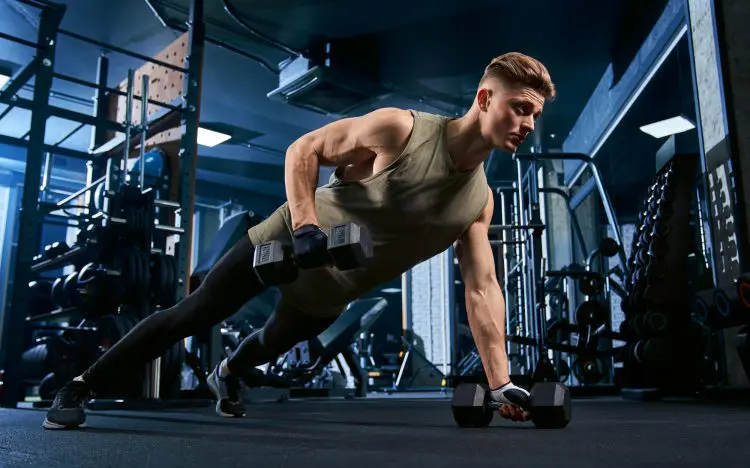
Steps:
- Hold a dumbbell in each hand. You can also use kettlebells.
- Squat down and place the weights on the floor, roughly shoulder-width apart.
- Brace your abs and walk your feet out and back into the push-up position. Your body should form a straight line. Keep your wrists straight, and do not allow them to collapse.
- Move your feet out so that they are wider than shoulder-width apart to increase balance and stability. Look straight down at the floor to ensure your neck is neutral.
- Keeping one arm straight, bend the other arm and row the weight up and into your lower ribs. Do NOT allow your hips or shoulders to twist.
- Lower the weight back to the floor, swap sides, and repeat. Alternate arms for the duration of your set, keeping your core braced throughout.
- You can also do this exercise with your legs bent and knees resting on the floor to take pressure off your core.
Muscles targeted:
- Primary: Rectus abdominis, obliques, transverse abdominis, latissimus dorsi, pectoralis major, deltoids, triceps.
- Secondary: Quadriceps, hip flexors, erector spinae.
Benefits:
- You can easily increase or decrease the difficulty of the exercise by using lighter or heavier dumbbells.
- A comprehensive exercise for your core and upper body.
- An excellent exercise for integrating the core, upper body, and lower body.
Tips:
- Use hex dumbbells if available, as they are more stable and less likely to roll.
- Make this exercise even harder by raising your feet on a bench.
- Do a push-up, lowering your chest between your hands, to increase pecs engagement.
3. Bear crawls
Bear crawls are a logical progression once you’ve mastered Spiderman planks. With this exercise, instead of just moving your legs, you move your arms, too, so you travel forward in a semi-plank position. This increases both core and upper body engagement and also produces a better conditioning workout.
Level Up Your Fitness: Join our 💪 strong community in Fitness Volt Newsletter. Get daily inspiration, expert-backed workouts, nutrition tips, the latest in strength sports, and the support you need to reach your goals. Subscribe for free!
Steps:
- Kneel down on all fours so your hands are directly under your shoulders and your knees are under your hips. Pull your toes up and press the balls of your feet into the floor.
- Brace your abs, pull your shoulders down and back, and rotate your elbows inward to engage your lats. Your lower back and neck should be neutral. Lift your knees a few inches off the floor while keeping your hips level with your shoulders.
- Without lifting your hips, move your left hand and right foot forward, then your right hand and left foot.
- Continue crawling forward over the specified distance or number of steps.
- You can also bear crawl backward, sideways, and diagonally.
You can read more about bear crawls here.
Muscles targeted:
- Primary: Rectus abdominis, obliques, transverse abdominis, deltoids, triceps, pectoralis major.
- Secondary: Quadriceps, hip flexors.
Benefits:
- An excellent full-body strength and conditioning exercise.
- Good for developing mobility, stability, and coordination.
- A great movement for circuit and HIIT workouts.
Tips:
- Wear gloves to protect your hands if you do bear crawls outdoors.
- Raise your hips to put more weight on your arms and shoulders.
- Move slowly to keep your muscles under tension for longer and make the exercise harder, i.e., a sloth crawl.
4. Walkouts
Walkouts are a challenging core exercise. With this exercise, you walk your hands out along the floor to put yourself in an extended plank position. This works the same muscles as Spiderman planks. But, because of the greater distance between your hands and feet, there is more tension on your core muscles.
Steps:
- Stand with your feet together, arms by your sides. Brace your abs.
- Hinging from your hips, lean forward and place your hands on the floor. Depending on your hamstring flexibility, you may need to bend your knees a little (or a lot!) to do this.
- Taking small steps, walk your hands forward as far as you can while maintaining your core stability. Do not let your hips drop or hyperextend your lumbar spine. Brace those abs! The further you walk your hands beyond your shoulders, the harder this exercise becomes. Hold this furthest point for a couple of seconds.
- Without relaxing your core, walk your hands back toward your feet and stand up. If you prefer, you can keep your hands on the floor and then transition immediately into another rep.
Muscles targeted:
- Primary: Rectus abdominis, obliques, transverse abdominis, triceps, deltoids, pectoralis major.
- Secondary: Quadriceps, hip flexors.
Benefits:
- An intense core exercise that requires no exercise equipment.
- Good for building core and shoulder strength and stability.
- Scalable by adjusting how far out you walk with your hands.
Tips:
- Bend your knees as much as necessary to get your hands flat on the floor.
- Keep your hands shoulder-width apart for comfort and joint health.
- Keep your abs flexed throughout for a more effective, safer workout.
5. Alternating T-plank
Just like Spiderman planks, this planking variation increases oblique or waist engagement as well as working your rectus abdominis. Balancing on one arm will also improve shoulder and triceps strength. The side-to-side motion of this exercise allows you to really overload your obliques, one side at a time.
Steps:
- Adopt the push-up position. Your arms should be straight with your hands pointing forward and roughly shoulder-width apart. Brace your abs and pull your shoulders down and back.
- Shift your weight onto one arm and rotate your shoulders and hips. Extend your non-weight-bearing arm up to the ceiling to form a T-shape.
- Return your hands to the floor, swap arms, and repeat on the other side.
- Continue alternating sides for the prescribed duration.
Muscles targeted:
- Primary: Rectus abdominis, obliques, transverse abdominis, deltoids, triceps.
- Secondary: Pectoralis major, latissimus dorsi, quadriceps, hip flexors.
Benefits:
- A good exercise for mobility, coordination, and stability.
- Ideal for circuit training and conditioning workouts.
- Can also be done using weights for a more demanding workout.
Tips:
- Use a mat for comfort and to prevent accidental slipping.
- Keep your body perfectly straight throughout.
- Reach for the sky to maximize oblique engagement.
6. Mason twists
While Mason twists don’t look much like Spiderman planks, they work most of the same muscles. However, where those muscles work statically during Spiderman planks, they work much more dynamically during Mason twists.
Steps:
- Sit on the floor with your legs bent. Lean back and lift your feet a few inches off the floor so you are balancing on your butt.
- Clasp your hands together in front of your chest.
- Without lowering your legs, turn your shoulders and touch your hands on the floor just outside your left hip.
- Switch sides and repeat.
Muscles targeted:
- Primary: Obliques, rectus abdominis, transverse abdominis.
- Secondary: Hip flexors, quadriceps.
Benefits:
- No equipment is required for this exercise.
- Minimal set-up time, so ideal for fast-paced workouts like HIIT and circuits.
- A straightforward exercise that’s suitable for beginners.
Tips:
- Lean back more and lift your legs higher to make this exercise harder.
- The faster you turn, the more unstable you’ll be and the more challenging this exercise becomes.
- You can also do this exercise with weight, i.e., holding a dumbbell or medicine ball.
7. Side plank leg raises
Side planks provide your obliques with a good workout, but, like most bodyweight abs exercises, all too soon, they will lose some of their effect, and you’ll need to do them for longer and longer. This side plank variation involves a leg raise which makes them more challenging. You can also do this exercise for reps instead of a predetermined time.
Steps:
- Lie on your side with your body straight and resting on your bent arm. With your legs together, raise your hips up, so your weight is supported on your lowermost foot and arm only. Brace your abs.
- Without raising or lowering your hips, lift your uppermost leg until your foot is roughly level with your shoulder.
- Lower your leg and repeat.
- Swap sides and do the same number of reps with the other leg.
Muscles targeted:
- Primary: Obliques, rectus abdominis, transverse abdominis.
- Secondary: Gluteus medius, gluteus minimus, tensor fascia latae.
Benefits:
- An effective way to overload your obliques.
- A good way to fix left-to-right strength imbalances.
- A useful exercise for integrating your legs with your core.
Tips:
- You can also do this exercise with your arm straight and resting on your hand.
- Raise your leg forward or backward of your hip to increase instability and make the exercise harder.
- Wear ankle weights for a more intense leg and core workout.
Spiderman Plank FAQs
Got a question about Spiderman planks or core training in general? No worries – we’ve got the answers!
1. How many reps and sets should I do of Spiderman planks?
Because Spiderman planks are a bodyweight exercise, it’s not really possible to give you a precise rep count to aim for. Some people will be able to fatigue their muscles in 30-40 seconds or 8-12 reps, while others will need more. It all depends on your weight and fitness.
So, simply do as many reps as it takes to get close to muscular failure. By the end of your set, you should be able to feel your abs working hard. Gradually do more reps as you get used to the exercise.
In terms of sets, 2-4 should be sufficient for most people. However, if you feel that you need to do more than four, you may not be taking your sets close enough to failure or are resting too long between efforts.
2. How many times a week can I do Spiderman planks?
2-3 times per week should be sufficient for most people. Fewer workouts mean you probably won’t get much better at Spiderman planks while doing them more often could lead to boredom or overuse injuries. Also, it’s best to have a day between Spiderman plank workouts for your muscles to recover and adapt (i.e., get stronger).
3. Will Spiderman planks get rid of my belly fat?
Unfortunately, no exercise will preferentially melt belly fat. To lose fat from your stomach, you also need to lose fat from the rest of your body. To achieve this, you need to eat a little less and exercise more to create a calorie deficit. This will force your body to burn fat for fuel.
Abs exercises like Spiderman planks target the underlying muscles. Still, you’ll need to lose fat from all over your body to eliminate belly fat.
4. Will Spiderman planks give me six-pack abs?
Believe it or not, you already have a six-pack. But if you can’t see it, it’s probably hiding under a layer of fat. Doing Spiderman planks will strengthen your abs and make them a little thicker, making them easier to see.
However, you’ll still need to drop body fat if you want to reveal your abs and show them off. For men, this means getting your body fat down to around 10%, and women need to hit approximately 15% for their abs to be visible.
Find out how to get ripped and reveal your six-pack abs here.
5. Why is this exercise called Spiderman planks?
No, this exercise wasn’t invented by Peter Parker – Spiderman’s not-so-secret identity. Rather, when you do Spiderman planks, you look a bit like you are crawling up a wall like a gravity-defying spider. They could just as easily be called knees-to-elbow planks, but Spiderman planks sound way cooler!
6. What other bodyweight abs exercises do you recommend?
There are dozens, if not hundreds, of effective bodyweight abs exercises, ranging from very easy to ultra-hard. Examples include:
- Crunches
- Sit-ups
- Planks and side-planks
- Hanging knee and leg raises
- V-sits
- Chinnies
- Bicycle crunches
- Oblique crunches
- Dragon flags
- Toes-to-bar
- Human flags
Discover more in our bodyweight abs exercise library.
7. Do I really have to train my entire body to get six-pack abs?
Your abs are one muscle out of 206, and if you want a six-pack, you should train the rest of your body, too. While there is nothing wrong with emphasizing your abs, you’ll achieve your six-pack goal sooner if you also develop your legs, arms, and torso.
If nothing else, exercising the rest of your body will increase your overall caloric expenditure and make fat loss easier and faster. Your abs are a relatively small muscle group, and even intense core workouts won’t burn many calories.
So, train your whole body even if getting a six-pack is your primary fitness objective.
8. How important is nutrition for getting six-pack abs?
The short answer is VERY! If your abs are covered in a layer of fat, no one will be able to see them. To reveal your sculpted abs, you need to shed excess fat, and that means reducing your calorie intake so your body is forced to burn fat for fuel.
Exercise will help too, but, as the saying goes, you can’t out-train a bad diet. Eating a healthy diet, losing fat, and training hard all play a part in achieving a six-pack, and, as bodybuilders like to say, abs are made in the kitchen!
Learn how to fix your diet in six weeks here.
Spiderman Planks – Wrapping Up
While planks are undeniably popular, they will soon start to lose their effect once you can hold a plank for more than a couple of minutes. Not only are prolonged planks boring, but they’re also ineffective. You don’t do sets of 50-100 reps of curls for your arms, so it makes no sense to do such prolonged sets for your abs.
The most effective way to develop your muscles is to overload them in a reasonable time frame, say 30-60 seconds. That means, for bodyweight exercises, you need to find new ways to make your chosen movements more challenging.
Switching from regular planks to Spiderman planks is one way to increase the difficulty of your core workout. But, even then, this new exercise will gradually lose its potency as you get stronger.
The good news is that there are plenty of similar but more challenging abs exercises you can use to sculpt the midsection of your dreams, and you’ll find seven of them in this article!
Interested in measuring your progress? Check out our strength standards for Push Ups, Sit Ups, Bicycle Crunch, and more.




